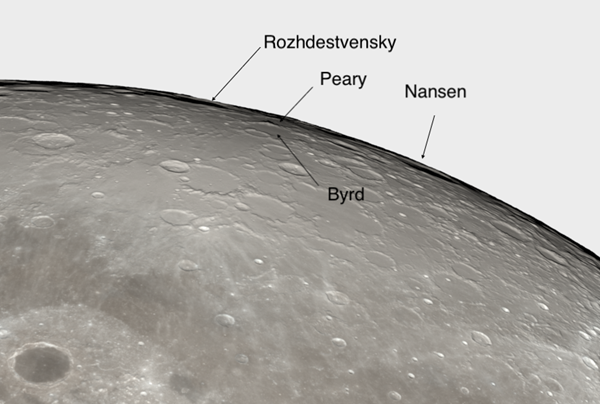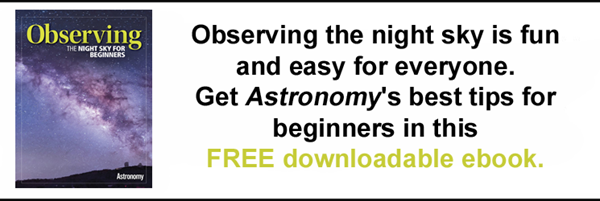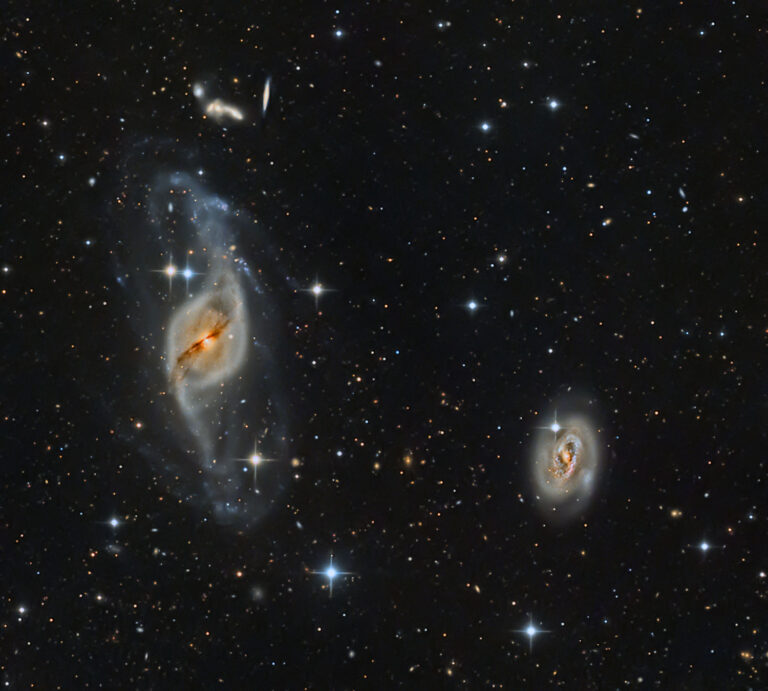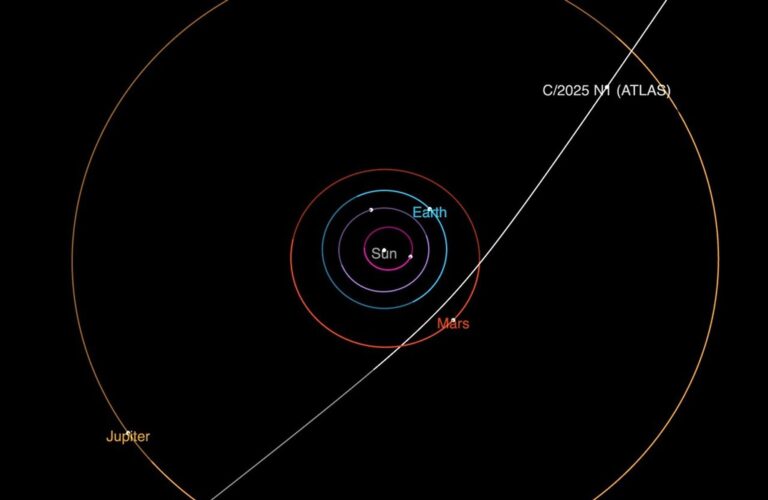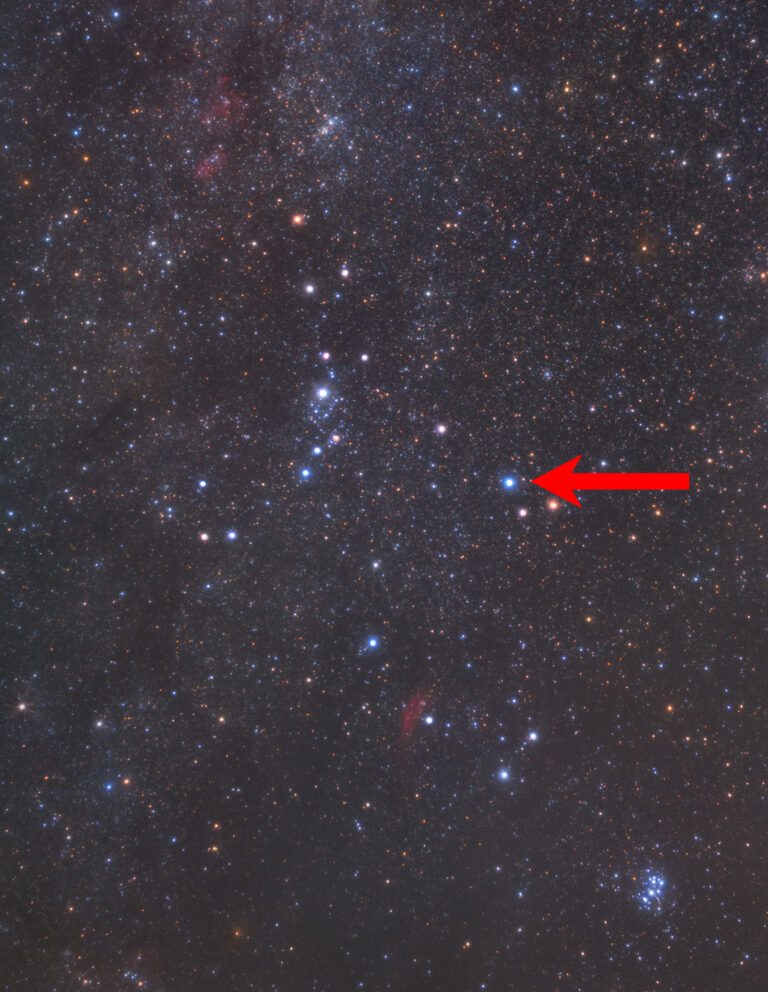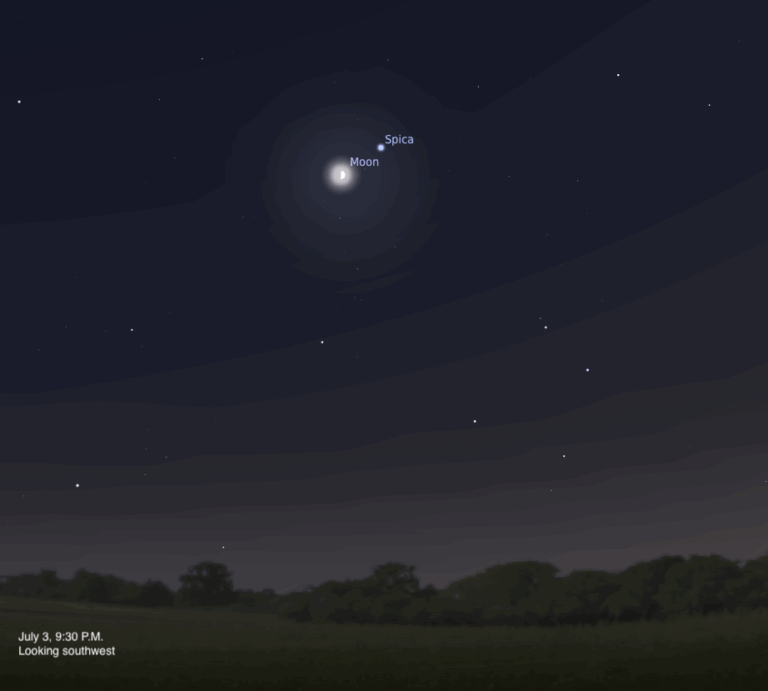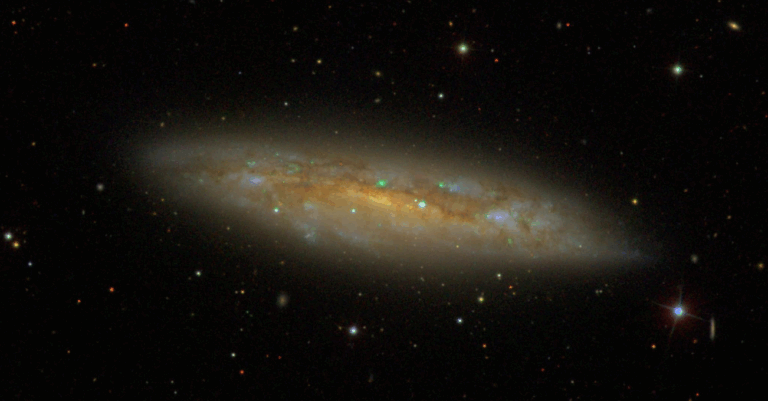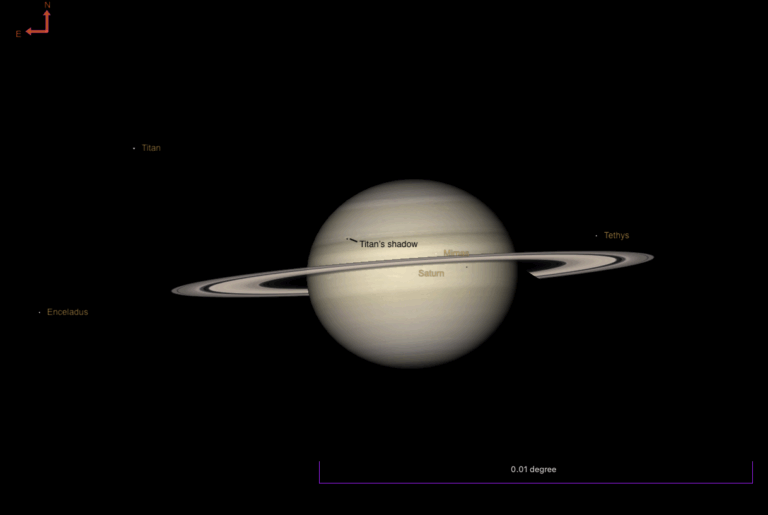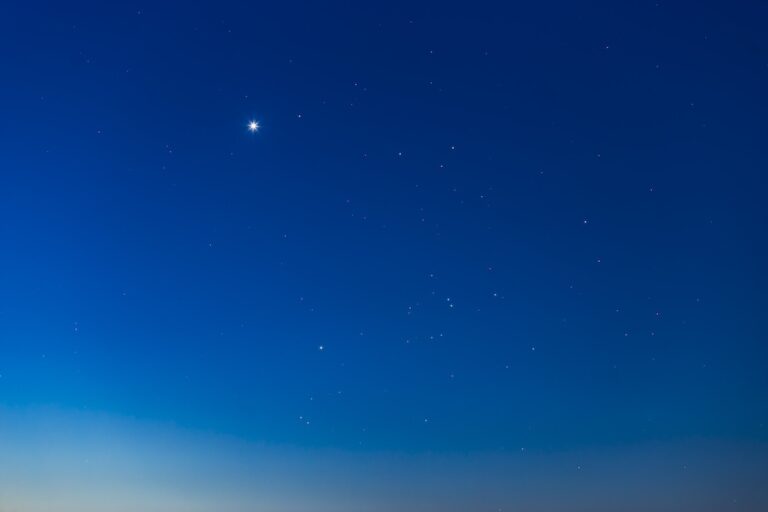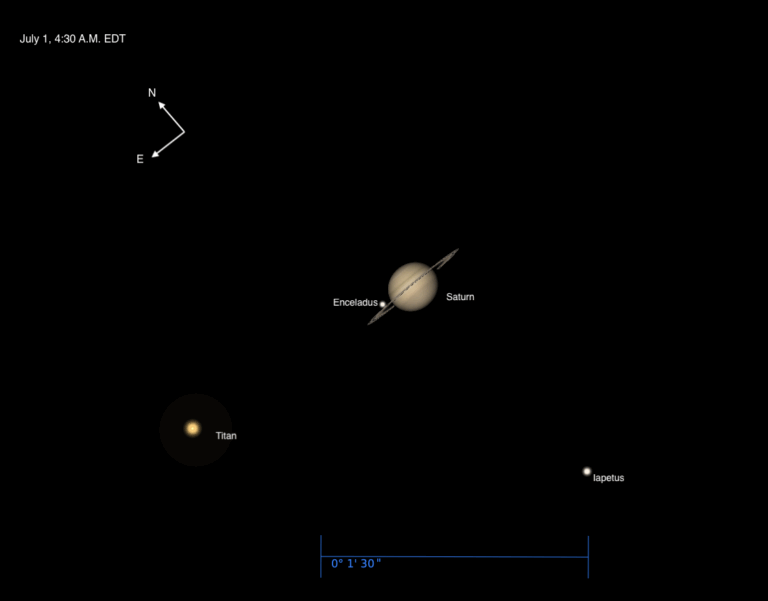Key Takeaways:
Friday, August 20
The Moon passes 4° south of Saturn at 6 P.M. EDT. By sunset, the pair is 4.5° apart and rising in the southeast. An hour later, the pair has separated by another 0.2° and is easy to pick out in central Capricornus.
Just two weeks past opposition, Saturn is magnitude 0.2 and remains visible all night long. To really make the most of the view, use a telescope to get a closer look at the planet’s stunning ring system. Although they stretch far to either side of the planet, the rings are extremely thin, some 100 yards (91 meters) thick! We have a great view for now, while they’re tilted 18° to our line of sight. When our perspective gives us a view of the rings edge-on, called a ring plane crossing, they virtually disappear. The next ring plane crossing will be in 2025, but Saturn will be too close to the Sun at that time for us to observe. The next observable crossing is in 2038.
With the bright Moon nearby, you might only be able to pick out the planet’s largest, brightest satellite, Titan, which today sits about 2′ east of Saturn. Titan orbits with a period of just under 16 days. We’ll revisit this moon later this week, when it’s completed a quarter of that orbit and appears due south of Saturn.
Sunrise: 6:16 A.M.
Sunset: 7:49 P.M.
Moonrise: 7:14 P.M.
Moonset: 3:48 A.M.
Moon Phase: Waxing gibbous (96%)
*Times for sunrise, sunset, moonrise, and moonset are given in local time from 40° N 90° W. The Moon’s illumination is given at 12 P.M. local time from the same location.
Saturday, August 21
The Moon is nearly Full and if you look at it with a telescope, you’ll notice that just like last month, there’s a plethora of terrain at the lunar north pole that’s not usually visible. That’s because, from our perspective on Earth, the Moon appears to bob up and down in its orbit — an effect called libration. And just like last month, we’ve got another top-down view this month, allowing us to peek at some of the features on the Moon’s more mysterious farside.
See if you can spot lesser-known craters such as Rozhdestvensky, Nansen, Peary, and Byrd. If the glare is getting to you, pump up the magnification on your scope — it may seem counterintuitive, but higher magnification reduces your field of view, which also cuts down on the amount of moonlight streaming into your eyes.
Even without a telescope, the nearly Full Moon is a beautiful sight to behold. Its nearside is draped with dark maria, or seas, that never held water but are in fact ancient lava flows that are younger than the lunar highlands. The farside has a dearth of such features, instead showing off older, more heavily cratered terrain.
Sunrise: 6:17 A.M.
Sunset: 7:48 P.M.
Moonrise: 7:52 P.M.
Moonset: 4:59 A.M.
Moon Phase: Waxing gibbous (99%)
Sunday, August 22
The Moon passes 4° south of Jupiter at 1 A.M. EDT. At that time, the two are some 35° high in the southern sky, impossible to miss. Jupiter, which appears directly above the Moon, is magnitude –2.9 — still visible even in the bright wash of moonlight nearby. Both straddle the border between Capricornus (to the west) and Aquarius (to the east). The star visible at a point west of a line drawn between them is Deneb Algedi, also known as Delta (δ) Capricorni. Look about 17.5° to the Moon’s lower left (southeast) to spot the star Fomalhaut in Piscis Austrinus the Southern Fish.
If you’re able to zoom in on Jupiter with a telescope, you might spot its four Galilean moons, arranged with two on either side of the planet: Europa (farthest) and Ganymede sit nestled close to each other to the east, while Io and Callisto (much farther out) lie to the west. If you track the moons into the morning twilight, you’ll see them growing closer to the planet, as if pulled inward by strings. Their relative positions, however, don’t change.
Full Moon occurs about two hours after sunrise, at 8:02 A.M. EDT. It won’t be visible then, but you can catch it within an hour of sunset this evening. The August Full Moon is traditionally called the Sturgeon Moon. But this Full Moon is also a Blue Moon, as it is the third Full Moon in a season containing four total Full Moons. (Note that this is a different definition, first used in 1528 according to NASA, than the more popular — and much more recently coined — term, which refers to two Full Moons in a single month.)
Sunrise: 6:18 A.M.
Sunset: 7:46 P.M.
Moonrise: 8:24 P.M.
Moonset: 6:10 A.M.
Moon Phase: Full
Monday, August 23
The Moon passes 4° south of Neptune at 10 P.M. EDT. At that time, the pair are still relatively low in the east, both in southeastern Aquarius. The bright Moon, although beautiful, will make finding the distant ice giant more challenging.
Neptune glows just slightly brighter than 8th magnitude and can generally be seen with either binoculars or a telescope. It will appear as a slightly “flat” star sitting directly between two slightly brighter (magnitude 6.5 and 7) field stars. It also forms the apex of a triangle with the Moon and 4th-magnitude Phi (ϕ) Aquarii as its base.
Another 4° or so north of Neptune is the Circlet of Pisces — an asterism, or unofficial grouping of stars, that traces out the head of one of the two fish that make up the constellation. The Circlet contains Seven stars: Gamma (γ), 7, Theta (θ), Iota (ι), 19, Lambda (λ), and Kappa (κ) Piscium. Don’t mistake bright Beta (β) Piscium as one of the Circlet’s stars — it lies a little above the halfway point of a line drawn between Gamma and Theta, and is not part of the asterism.
Sunrise: 6:19 A.M.
Sunset: 7:45 P.M.
Moonrise: 8:52 P.M.
Moonset: 7:19 A.M.
Moon Phase: Waning gibbous (98%)
Tuesday, August 24
For amateurs with a 6-inch scope or larger and dark, country skies, Comet 4P/Faye is a tempting target as it slides past the Hyades. Rising around midnight, wait until an hour or two before dawn to give Taurus time to reach a better position higher in the sky. The gibbous Moon is unfortunately also hanging around, but will only draw closer over the coming days, so now is one of your last best chances to enjoy the comet amid the pleasantly crowded smattering of stars that mark the Bull’s face.
This morning, Faye’s 10th magnitude fuzz floats just 0.5° east-southeast of Epsilon (ϵ) Tauri, also called Ain. And about 2° west-northwest of the comet is Hind’s Variable Nebula (NGC 1554/5), which, between the bright moonlight and the need for a large telescope to see it, is likely off-limits to most observers. This unique nebula might appear under the careful attention of an experienced astrophotographer. Hind’s Variable Nebula and its associated young star, T Tauri, both vary in brightness irregularly with time. The nebula also varies in size and shape. If you’ve got a large amateur scope and some time on your hands, give it a try, especially after the Moon is gone. You may also want to come back to this spot later this year, ideally at a time when Taurus is even higher in the sky and there is no bright Moon.
Sunrise: 6:20 A.M.
Sunset: 7:44 P.M.
Moonrise: 9:17 P.M.
Moonset: 8:25 A.M.
Moon Phase: Waning gibbous (94%)
Wednesday, August 25
Asteroid 89 Julia reaches opposition at 7 A.M. EDT this morning. You can begin looking for this small solar system world later today as soon as it gets dark; by an hour after sunset, it’s already 22° high and climbing amid the stars of Aquarius. Discovered by French astronomer Édouard Stephan this month in 1866, the main-belt asteroid is named for Saint Julia of Corsica.
There are a few bight signposts to guide your way. Julia currently sits 13.7° north-northeast of Jupiter, which floats nearby in Capricornus. Much closer is Sadalmelik, Aquarius’ 3rd-magnitude alpha star: Julia lies 1.5° west of this star.
You’ll want to be quick in your search, however — the Moon will rise nearby around 9:40 P.M. local time, likely washing out Julia’s magnitude 8.9 glow for most and making the space rock harder to find. The Moon tonight straddles the border of Pisces and Cetus, moving fully into the Fish as the night progresses.
Sunrise: 6:21 A.M.
Sunset: 7:42 P.M.
Moonrise: 9:40 P.M.
Moonset: 9:29 A.M.
Moon Phase: Waning gibbous (89%)
Thursday, August 26
The moon Titan sits due south of its parent planet Saturn tonight. You’ll find them both in the constellation Capricornus, already well above the horizon in the southeast as the Sun sets. Once it’s darker, zoom in on the ringed planet with a telescope to see if you can spot the sight of its largest moon 1′ to its south. If you can catch the planet before moonrise, see if you can spot any of its other, fainter moons as well. Tenth-magnitude Tethys and Rhea are lined up nicely off to Saturn’s east, with Tethys closer to the planet. A more challenging 12th magnitude, Enceladus sits on that same line, but off to the planet’s west.
Saturn itself has a polar diameter of 17″ and is currently showing off its southern regions quite well. Although the disk is usually largely featureless, observers with larger scopes, steady seeing, and little light pollution may note some subtle detail, especially if there are storms — which appear as white spots — active in the cloud tops.
Sunrise: 6:22 A.M.
Sunset: 7:41 P.M.
Moonrise: 10:03 P.M.
Moonset: 10:30 A.M.
Moon Phase: Waning gibbous (82%)
Friday, August 27
There’s a planetary lineup in the evening sky if you’re fast enough to catch it. Twenty minutes after sunset, Mars sits just 2° above the western horizon. The dim planet (magnitude 1.8) will slip away quickly and requires binoculars to see — but make sure not to look for it until the Sun is completely gone. If you have a go-to scope, Mars sits just off Sigma (σ) Leonis, Leo’s back foot, a little less than 1° southwest of the star.
At that same time, Mercury is slightly higher (5°) — still challenging, though! — and brighter (magnitude –0.1). It’s over the invisible border in Virgo, and sits 8.5° east of Mars. Its tiny, 6″-wide disk should be visible in a telescope, showing off a crescent that’s 78 percent lit.
The final planet in line this evening is Venus. A further 17° east of Mercury, it’s ripe for viewing, hanging 12° high and blazing at magnitude –4. Through a telescope, Venus is nearly the same phase as Mercury, showing a 74-percent-lit crescent, but it’s more than twice as wide, appearing 15″ in diameter. This evening star will linger a short while after dark, sinking below the horizon around 9 P.M. local time. Once the stars start to come out, look for 3rd-magnitude Porrima to Venus’ northwest and 1st-magnitude Spica to the planet’s east-southeast.
Sunrise: 6:23 A.M.
Sunset: 7:39 P.M.
Moonrise: 10:28 P.M.
Moonset: 11:32 A.M.
Moon Phase: Waning gibbous (73%)


